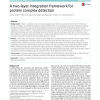Free Online Productivity Tools
i2Speak
i2Symbol
i2OCR
iTex2Img
iWeb2Print
iWeb2Shot
i2Type
iPdf2Split
iPdf2Merge
i2Bopomofo
i2Arabic
i2Style
i2Image
i2PDF
iLatex2Rtf
Sci2ools
BMCBI
2016
2016
A two-layer integration framework for protein complex detection
Background: Protein complexes carry out nearly all signaling and functional processes within cells. The study of protein complexes is an effective strategy to analyze cellular functions and biological processes. With the increasing availability of proteomics data, various computational methods have recently been developed to predict protein complexes. However, different computational methods are based on their own assumptions and designed to work on different data sources, and various biological screening methods have their unique experiment conditions, and are often different in scale and noise level. Therefore, a single computational method on a specific data source is generally not able to generate comprehensive and reliable prediction results. Results: In this paper, we develop a novel Two-layer INtegrative Complex Detection (TINCD) model to detect protein complexes, leveraging the information from both clustering results and raw data sources. In particular, we first integrate var...
| Added | 30 Mar 2016 |
| Updated | 30 Mar 2016 |
| Type | Journal |
| Year | 2016 |
| Where | BMCBI |
| Authors | Le Ou-Yang, Min Wu, Xiao-Fei Zhang, Dao-Qing Dai, Xiaoli Li, Hong Yan |
Comments (0)

